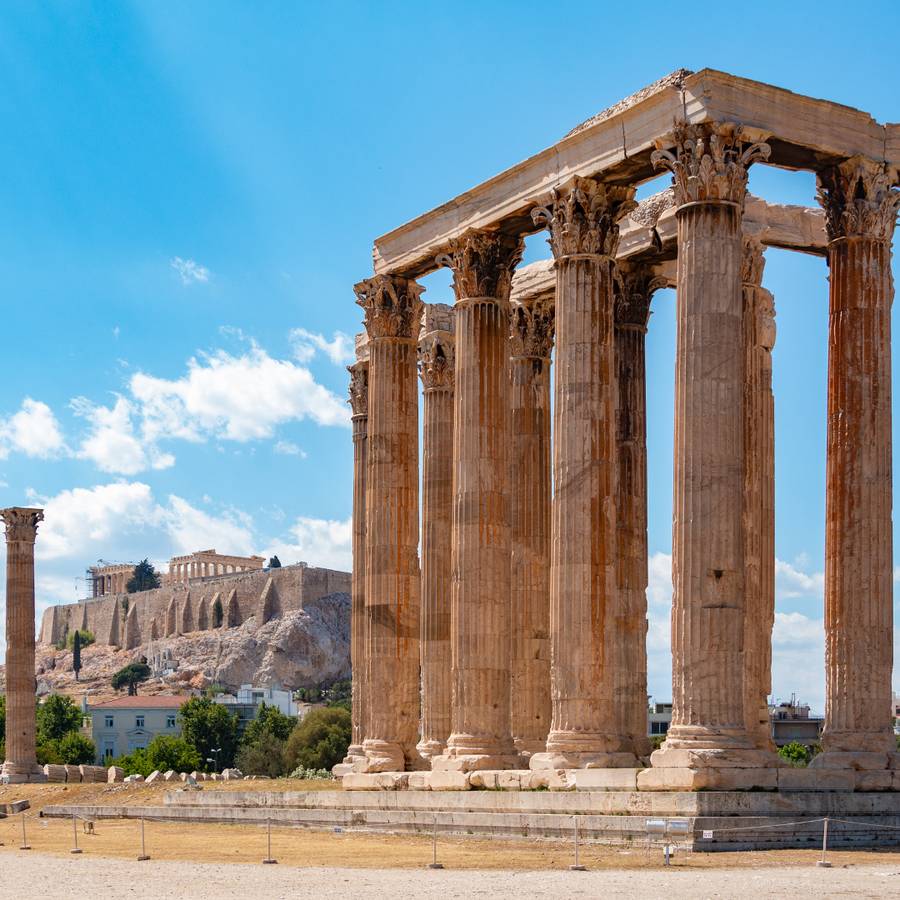See the most famous Ancient Sites in 3 days!

The main archaeological sites in Athens are listed below. The majority of them are sizable areas with interesting things for people to view. Archaeologists continue to conduct excavations at these locations, which are a part of Athens' well-documented archeological past. Let's look into these.
Acropolis
It is undoubtedly the most visited ancient monument in Athens and is debatably one of the most recognizable in the entire globe. The ruins of ancient temples and sanctuaries, the most famous of which is the Parthenon, from the fifth century BCE to the Roman period are highlighted and the subject of restoration work, even though there is evidence of activity on the site dating back to 5,000 years. The history of the Acropolis post-Roman times has all but been erased, and what little is said about it is usually unfavorable.
The Acropolis is a symbol of ancient Greece and its cultural heritage. It is situated on a rocky outcrop overlooking Athens, and its prominent position gave it strategic and symbolic importance throughout history. The site was initially used for religious purposes and was considered a sacred place. Many of the temples and sanctuaries were built to honor the gods and goddesses of ancient Greece, such as Athena, Zeus, and Dionysus.
The most famous building on the Acropolis is the Parthenon, which was constructed in the fifth century BCE and dedicated to Athena Parthenos, the patron goddess of Athens. The temple was a masterpiece of classical architecture, with its impressive columns, pediments, and friezes adorned with intricate sculptures. The Parthenon served as a symbol of Athenian democracy and power, and it still fascinates visitors today.
Over the centuries, the Acropolis underwent numerous changes and renovations. During the Roman period, many of the original buildings were converted into churches, and new structures were added. However, the Acropolis gradually fell into disrepair, and by the 18th century, it was in a state of ruin.
The restoration of the Acropolis began in the 19th century, and it continues to this day. The restoration work is an ongoing process that aims to preserve the ancient monuments for future generations. The restoration work has been a challenging task, as it involves careful and meticulous restoration of the original materials and techniques used in the construction of the buildings.
The Acropolis is not only an important archaeological site, but it is also a cultural and educational center. It attracts millions of visitors every year, who come to see the magnificent monuments, learn about the history of ancient Greece, and experience the breathtaking views of Athens from the top of the hill.
In conclusion, the Acropolis is a remarkable monument that represents the cultural heritage of ancient Greece. It is a testament to the ingenuity and creativity of the ancient Greeks and serves as a reminder of their contributions to Western civilization. The Acropolis is a must-see destination for anyone interested in history, architecture, or culture.
Ancient Agora
The Ancient Agora served as the heart of ancient Athens' government. Administrative structures and temples encircled a sizable open square where several public events were held. The Hephaisteion, a temple of Hephaistos that is the best preserved in all of Greece, looks out over the Agora. The Agora was a stop on the Panathenaic Road that led to the Acropolis. The Museum of the Ancient Agora, located in the Attalos Stoa that has been rebuilt, is included with admission to the archaeological site.
The Ancient Agora served as the heart of ancient Athens' government. Administrative structures and temples encircled a sizable open square where several public events were held. The Hephaisteion, a temple of Hephaistos that is the best preserved in all of Greece, looks out over the Agora. The Agora was a stop on the Panathenaic Road that led to the Acropolis. The Museum of the Ancient Agora, located in the Attalos Stoa that has been rebuilt, is included with admission to the archaeological site.
The Ancient Agora was not only the center of government but also the hub of commercial activity in ancient Athens. The market stalls and shops that lined the streets surrounding the Agora sold goods ranging from food to pottery to textiles. It was a bustling hub of commerce and trade, and it played a vital role in the economic life of Athens.
The Ancient Agora was also a center for intellectual and cultural activities. It was home to the Stoa of Attalos, a large covered walkway where philosophers and scholars would gather to discuss and debate their ideas. The Stoa of Attalos was a magnificent architectural achievement, and it has been reconstructed today to give visitors a sense of what the original structure may have looked like.
In addition to its role as a hub of government, commerce, and culture, the Ancient Agora was also a place of religious significance. The Temple of the Winds, a small temple dedicated to the god of the winds, was located on the northern side of the Agora. Other religious structures were scattered throughout the site, including shrines and altars dedicated to various gods and goddesses.
Today, the Ancient Agora is a popular tourist destination and a valuable archaeological site. Visitors can explore the ruins of the many buildings that once stood on the site and learn about the history and culture of ancient Athens. The site is a testament to the achievements of the ancient Greeks and a reminder of the enduring legacy of their civilization.
Archaeological Site and Museum of Kerameikos
The oldest and largest ancient cemetery of Kerameikos is a short stroll from the main collection of prehistoric sites to the northwest of the Acropolis. The potters who created the famous "Attic vases" lived and worked in this area, which was one of ancient Athens' major neighborhoods. A portion of the Themistoclean Wall, the Dipylon Gate, and the Holy Gate is visible in addition to the funerary elements. The site's artifacts, which largely focus on burial customs and rituals throughout time, are shown in the on-site museum.
Olympieion, The Olympian Zeus Temple
The enormous Temple of Olympian Zeus, one of the biggest Classical temples, may be viewed from the street, but it is unquestionably a monument that ought to be seen up close. The temple had 104 columns when Hadrian finished building it in the second century AD. Only 16 of these are still standing today. A Roman bathhouse, a basilica, and the remains of the city walls are just a few of the various attractions that can be seen there.
Athens National Archaeological Museum
Some of the most famous artifacts from the entire contemporary nation-state of Greece are housed in Athens' National Archaeological Museum. Ancient artifacts from Egypt and Cyprus are featured in distinct collections that span prehistory through the Roman era. Despite various additions since then, the museum has been housed in the existing building with its beautiful Neoclassical façade since 1889. Anybody interested in ancient Greece must visit this location, which has the world's largest collection of ancient Greek artifacts.
It is important to note that 18 April is the International Day of Monuments and Archaeological Sites, which entitles visitors to free admission to archaeological sites, and 18 May is World Museum Day, which entitles visitors to free admission to both museums and archaeological sites in Athens.

